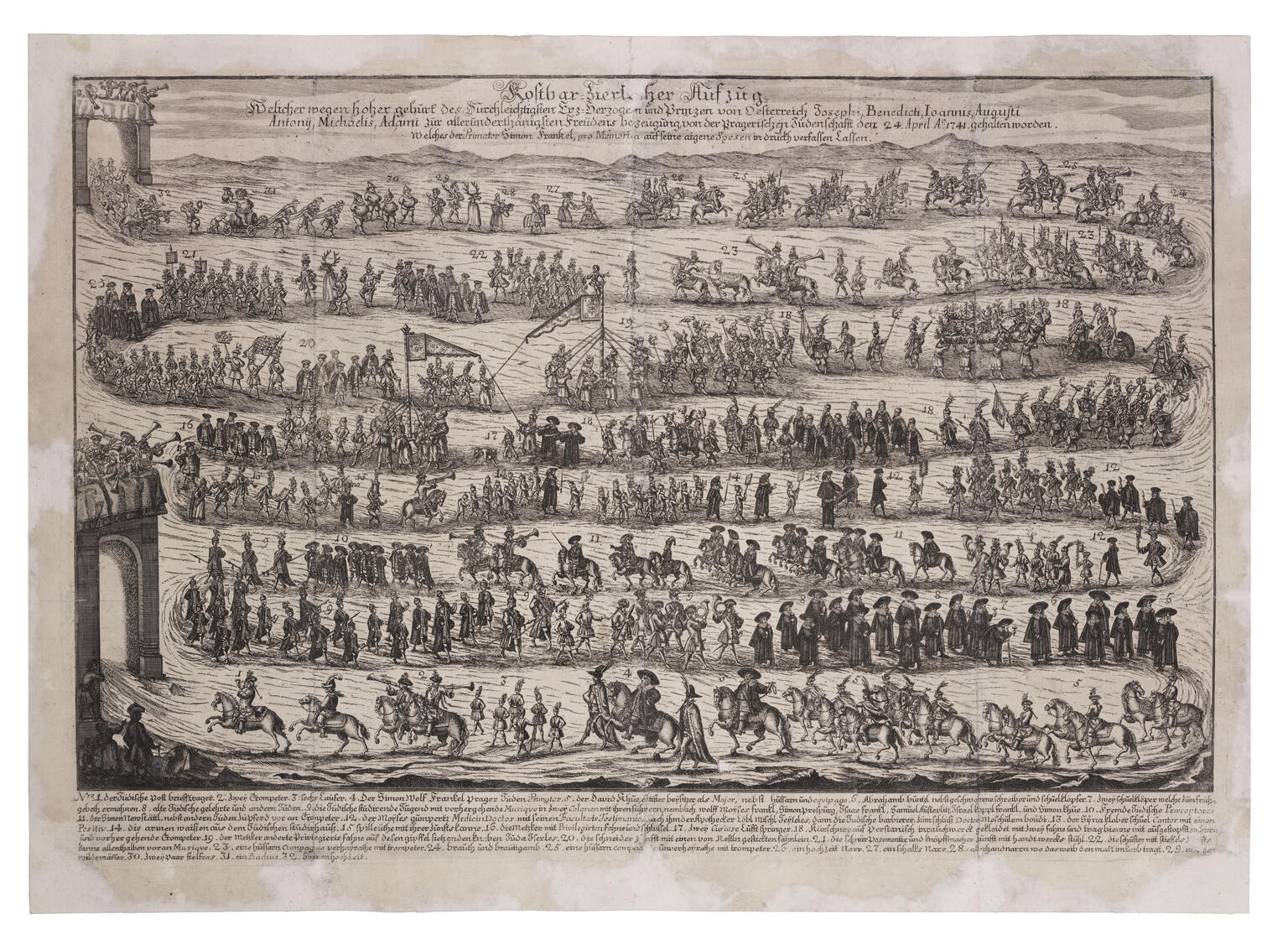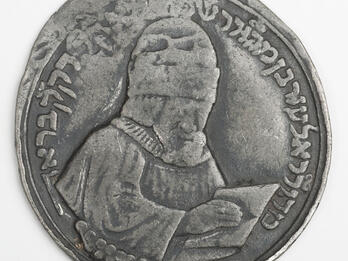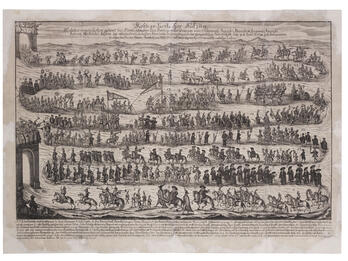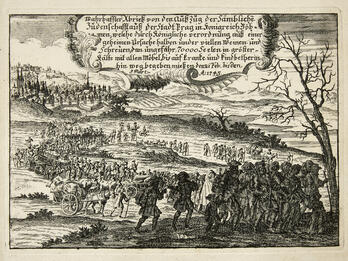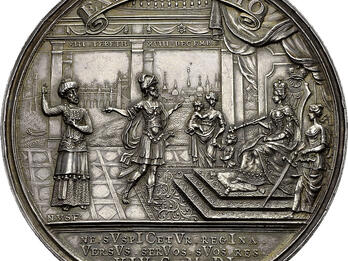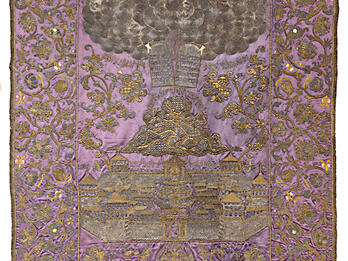Description of the Celebratory Procession of Prague Jewry
Description of a most humble joyous demonstration, a fine lavish procession and two-time illumination, held in honor of the exalted birth of his Serene Highness, the Archduke and Prince of Austria, Joseph, Benedict, Joann, August, Anton, Michael, Adam, by the Jews of Prague on April 24 of the year 1741
Therefore, when Her Most Serene Highness and Majesty, the Queen of Hungary and Bohemia, Arch-Duchess of Austria, and Grand-Duchess of Tuscany, gave birth to a long-desired prince, as soon as this most pleasant news about such an exalted birth became known in Prague, Simon Wolf Frankel—formerly vice-, but now most graciously appointed as the actual Primator already on the 21st of March—and the elders, as well as other aldermen of the Jewish community, organized an Illumination in honor of Her Most High Majesty the Queen and the newborn Prince. The Jewish elders forbade opening stalls and commerce that day in the Tandel Market, but in the afternoon at about three o’clock, ordered the two banners or flags to be carried joyfully through the Jewish Town accompanied by all kinds of music. The Primator Frankel tossed a considerable amount of coins to the poor and at the same time permitted money, bread, fish, meat, and other food supplies be carried to those incarcerated in all the prisons, whether in the Town Hall, Schlachter Street or the Jewish lockup. Afterward, at five o’clock, nearly all Jews repaired to worship in their synagogues celebrating the birth of the newborn Prince and Archduke Joseph conceived by Her Highness, Queen Maria Theresia, with prayers from the Psalms accompanied with music, illuminated by many lights. Then about half past six, rich as well as poor in the entire Jewish Town illuminated the windows facing both out and inward of their dwellings, as well as the tower on the Jewish Town Hall. Moreover, an honorary scaffolding was set up upon which French horns blared with joyful sound, and the elders and aldermen together held a meeting at the said Town Hall until after midnight with great illumination and merriment.
Furthermore, most humbly honoring the exalted birth, the aforementioned Primator Simon Frankel, with the addition of assistant officers namely, David Löbel Khue, Prague Jewish elder assessor, and the elders Samuel David Koreff and Jacobs Kallmuss the attorney, both two certified German scribes, as well as Isaac Baruch Austerlitz representing the taxpaying members of the community, conceived and devised in a short time a program that will now be surveyed more thoroughly in what follows.
I. In the first place, the Jewish Primator arranged that the stalls in the Jewish Town upon whose rooftops spectators gathered in order to see better, should be removed a few cubits away from the houses and barriers be set up.
II. So too, the high nobility living in Prague, spiritual and secular, as well as the judges of the upper and lower courts, then ladies, were invited to the solemn procession held on April 24. (Various high ministers, prelates, also princely persons, dames, honorable magistrates of the royal cities of Prague, together with several other spectators, were each issued a voucher to be quartered in select houses.)
III. By the gates of three streets, namely the Altschul, Pinkas Synagogue and Juden-Platz gates, galleries draped with rugs were made, upon which trumpeters greeted the arrivals.
IV. His Excellency, the General and Commandant, in response to a request to ensure security put troops in place to prevent any possible disturbance of the peace.
V. On the said day of the procession, once again as stated above, Jews were not permitted to engage in trade in the Tandel Market.
VI. Moreover, it was arranged that throughout the day, Psalms were prayed in all the synagogues in return for distributed alms, fasting as well was held, and in the evening illuminated by many lamps, the synagogue ark curtains were hung.
VII. The aforementioned assistant officers drilled all participants, whether on foot or on horseback, the order of the march in the so-called Jewish Baths or Communal Courtyard and the former Goltzisch Courtyard, where at the stroke of four o’clock in the afternoon, the procession began in the following order:
I. It was the Jewish postal courier in a red attire, his post horn hanging by a cord, who rode ahead blowing the signal to “March!,” leading the well-behaved parade out of the Jewish Courtyard, then the so-called Goltzisch Courtyard, the Tummel Square, through the Pinkas-Schul Gate, down into the streets, through Golden Lane, over to Drei Brunnen Square, toward the Jewish Town Hall and other places.
II. Then blowing, rode two trumpeters in gala livery.
III. Six uniformly dressed couriers with bows, ribbons, as well as red with gold decorated aprons followed.
IV. The Jewish Primator of Prague, Simon Wolf Frankel, in a black-velvet synagogue-robe, a rich waistcoat, and a gold embroidered, black-velvet Grandezza on his head, on a smart looking riding-school capital-horse well-appointed with a rich equipage, and alongside two Hajduk attendants dressed in handsome livery.
V. Following him, David Löbl Khue elder councilman, riding as Major, in a black damask synagogue robe, rich waistcoat, golden sash draped across his body, embroidered synagogue hat; alongside him, six of the most beautiful and costly dressed Hungarian Hussars, then, six grooms of the Primator on smart equestrian-horses, rich equipage under which a precious, light red colored velvet saddlecloth embroidered with silver, which the Primator had made for himself so smartly for the occasion.
VI. Then went Abraham Bunzl, elder councilman, certified scribe and Schulklopfer in black holiday camelhair attire, with a quill stuck behind his ear.
VII. Summoning to early morning prayer at four o’clock, two Schulklopfer followed, one of whom was eighty-eight years old carrying in his hand a fine pewter synagogue gavel, the other, a gilded wooden one.
VIII. After them came walking behind them on foot, a great number of old Jewish scholars and other community members in damask synagogue robes, and wearing synagogue capes trimmed with fur, and decorated synagogue hats.
IX. Furthermore, with musicians and French horn trumpeters preceding them, follow young Jewish students in two columns with couriers in front; the first being led by Wolf Moyses Frankel, and Simon Abraham Prespurg, the alderman’s son, with partizan polearms; the rest in beautiful black velvet, Jewish damask robes and rich waistcoats, marten and sable trimmed caps richly decorated with gold, holding books with silver clasps in their hand; bringing up the rear, Isaac David Frankel, and Samuel Austerlitz Sachsel, the son of the commissioner Isaac Austerlitz mentioned at the beginning. The other column led by Israel Koppl Frankel and Simon David Khue with a gold sash, just like the above with partizan polearm in hand, and followed by local young students, in smart black velvet and damask robes, rich waistcoats, sable trimmed caps decorated with gold, marching with books in hand.
X. They were followed by a number of foreign Jewish preceptors with the shield of David in gold braid and the letter P stitched on their berets to distinguish the locals from the foreigners, preceded by music.
XI. Simon Aaron Neustadl in a black velvet attire, decorated beret, and rich waistcoat; after him Mändl Samuel Wedeles in a velvet synagogue robe and cloak trimmed with marten fur; after these two, a person in black-velvet noble costume, followed by several Jewish community members in velvet damask attire, rich waistcoats, and richly decorated berets, riding on horses with costly equipage.
XII. Moyses Salomon Gumperz, medical doctor and Jewish physician, in a black velvet German doctor’s habit, damask coat, ruffles and wig, preceded by a courier and two men dressed in Turkish habit with long gray beards, then Gumperz’s nine-year-old son named Joseph Löw, dressed fine and handsome, who carried on a tall staff bearing the diploma his father had received from the Medical Faculty. Alongside went Löbel Jaiteles, the son of the Jewish apothecary, the community elder Löbel Mischl Jaiteles, in a red-frilled scarlet coat, rich waistcoat, a gold baldric slanted across his chest, holding in his hands a pharmacist’s herbal canister; followed obediently by all the Jewish barbers in black attire with their instruments in their hands, the married ones in coats, the journeymen in all manner of smart clothes and braided silk ribbons on their hats as well as on their arms, with shaving bowls in their hands; finally, once again a Doctor Meschulem called Bondi or Eger, dressed in black velvet coat and damask cloak, wearing a wig.
XIII. Then with a positive or portable organ carried alongside, Sina Klaber, the community synagogue cantor read at the top of his voice, in two spots, namely at the Primator’s House at the so-called Drey Brunnen and the Jewish Town Hall, a well-wish concerning the most Gracious Queen and newborn Prince in the Hebrew language, and in German translation it reads as following:
God
The Almighty, who created heaven and earth, all the creatures, and our forefathers Abraham, Isaac, Jacob, Moses, Aaron, King David, his son Solomon, and also blessed all the kings of Israel, shall bless also our Most Gracious Queen maria theresia, her beloved husband His Royal Highness, and the happily newborn Royal Prince, and Archduke Joseph, Benedict, Joann, August, Anton, Michael, Adam, as well as the entire Serene Arch-House of Austria. God should raise, multiply, and increase the seat of Her kingdoms and lands. He should protect and shield Her from every evil and persecution. The Almighty should humble all Her enemies; they should fall at Her feet. Also protect Her in all places and conflicts. God should grant Her, and all Her heirs and the heirs of their heirs, every desired welfare, body and soul for all eternity, as well as faithful counselors, war heroes to strengthen on water and land, by which this kingdom will be exalted and enlarged, Amen.
XIV. And then, a great number of poor children and orphans from the Poor-Orphan-and-Jewish-Study-House in their everyday robes, blue and white flecked bonnets bound with red ribbons, carrying prayer books and writing tablets, with their school teachers alongside dressed in holiday clothes, all singing at the top of their voices the wish expressed in the seventy-second Psalm of King David for the Most Serene Queen and Prince. These orphans are maintained without a permanent fund, only by charity over which the Primator Frankel has served as inspector now thirty years.
XV. After that, following a trumpeter on horseback, came Jewish entertainers carrying a large pewter guild tankard, and previous guild-elders, dressed in new clothes with wings of blue and red color and similar miter caps on which Vivat was embroidered, accompanied by merry music. An entertainer of about eighty, dressed in women’s clothes with a bridal crown of pearl beads and waistband just as Jewish brides are wont to wear, blew a bassoon.
XVI. Then followed the guild of the Jewish shohets, where a master went ahead with a pewter key two and a half ell tall, and after him the oldest masters dressed in German style brown linen robes, black jackets and coats. Then proceeded the journeymen wearing clothes of the same colors as the Queen’s coat of arms, raw linen jackets with flower colored linen ruffles and facings, white-knit camel-hair buttonholes, festooned with silver baldrics, sewn aprons and green caps with bows and ribbons, holding meat cleavers with the emblem of the Bohemian lion. The rest of the masters wore white kittels, white caps and ruffs, carrying their beautiful red damask banner or flag with gilt inscriptions adorned with King David’s shield, fifteen ell tall, that had been granted as a privilege by the late Emperor and King Karl IV.
XVII. After which two Jewish unusual acrobats were seen with their merry arts, one of them placing the tips of two bare swords, one on an eye and the other on the heart, striking different bizarre postures, both dressed as couriers with ribbons and bows.
XVIII. Afterwards came a striking number of furriers behind two Jewish trumpeters in Sunday clothes, then two couriers. Their leader, Antschl Simon Loebl Wiener in a black velvet Hungarian fur and velvet sable cap, rich waistcoat slashed with gold thread, golden chain and scarf, rode on a riding school horse, and alongside him Nahum Trebitsch. These were followed by two Moors dressed in pelts; then the rest of the furriers came in three divisions: those in the first had their clothes sewn with precious furs; in the second, a standard was carried that was so artfully composed of various pelts, that it quite clearly presented the name of Her Majesty the Queen, MARIA THERESA, and the prince in the cradle; a large number followed the flag carrying poles with various stuffed animals, all dressed in precious pelts and other such textiles in Persian style; behind, a quite naturalistic young bear was led with pipe music, and six men carried a platform on which the decorated bushes and trees resembled a shrub and a small forest in which all imaginable stuffed animals revealed themselves. One of the marchers fired off various gunshots, and at times a lion roaring was heard. Finally, the third division came, carrying another banner composed of various textiles on which King David’s shield was artfully presented, followed by a notable number dressed like the previous divisions in precious pelts in the Persian manner, carrying various stuffed animals on poles.
XIX. Furthermore, once again the master butchers in white kittels carried another fifteen ell high, privileged banner or flag, on whose summit sat a twelve year old Jewish boy called Juda Jescaye Iserles in stylish delicate dancing clothes, who skillfully complimented all high lords, spiritual and secular, and ladies at the windows.
XX. Moreover, preceded by pleasant music, went the large numbered tailor guild; the Starschen, or guild elders, in black clothes and capes, had fastened some silk aiguillettes on their arms. And after them a delicately stitched together ensign of such aiguillettes was carried and the Tailor’s Shield, followed by smartly dressed apprentices with bows and braids on their hats.
XXI. And then came the so-called lace, cording and button-makers guild. These preceded the Starschen or guild elders in black German clothes and coats, after whom a small gilded work-stool was carried, and an artfully manufactured passementer shield. After this, came the apprentices smartly dressed in black with golden cording, scarfs, epaulettes and ribbons on their arms and hats, as well as nice shrubs.
XXII. They were followed by the shoemaker guild. In the front went the Starschen or guild elders in black German clothes, hats and coats, with an immensely large pewter guild tankard cast in the form of a boot on whose cover there was a shoemaker’s workshop with working journeymen; after these, the journeymen displayed themselves in various beautiful clothes.
XXIII. Furthermore, preceded by a groom on horseback, two trumpeters, and two couriers, rode marching a handsome hussar company of married Jews—among whom were Abraham Zebrak and Michel Jurist—on riding school horses, all with Hungarian furs decorated with gold, silver and gilded smartly decorated fabrics, also hats adorned with egret plumes and ribbons, spruced beards, and lances in hand, dressed in costly Hungarian fashion.
XXIV. These were followed by two well-formed youths on horseback, one of whom masqueraded as a Jewish bride preciously attired with a gold-trimmed ruffles, with a garland and band of precious pearls on his head; the other, a bridegroom, also expensively costumed, caressing his bride most affectionately.
XXV. In addition, a hussar company of bachelor Jews marched, led by two trumpeters; their smart Hungarian clothing consisted of velvet, damask, precious gold-trimmed furs, silver and gold brocade, draps d’or, all kinds of embroidered shirts, also hats decorated with gold, with egret plumes, ribbons; have also mustachios, lances in hands, riding on exceptionally beautiful horses with expensive saddlecloths decked out with braided ribbons.
XXVI. Hereafter rides a wedding jester, with all sorts of wooden cooking dishes, spoons and plates hanging on him, and wearing a wooden pot instead of a hat.
XXVII. Next to him a prankster dressed as a green harlequin on horseback could be seen.
XXVIII. Other fools follow: one dressed in women’s clothes pulled with reins a 40-year-old man pretending to be a child in a baby walker; this boy had a beer pacifier, and when he cried, the woman smeared his mouth with porridge; another was disguised as a woman carrying a man in a basket, making polite postures; another rode on a wooden horse, followed by one with a deer-head and on it antlers, all of which amused the audience providing much entertainment.
XXIX. In addition, a pair of wild men, almost naked and seemingly covered with hair, held large wooden clubs, and brawled with each other, until one of them slammed the club to the ground, splitting it asunder.
XXX. Behind these go two pairs of exceptionally fat gluttons stuffed with wool that function well to make their persons funny looking.
XXXI. No less funny is a carriage dragged by six persons in harness dressed in green, where Bacchus sits on a barrel and in a drunkard manner, repeatedly takes a swig from a mug.
XXXII. Bringing up the rear is a merry farmer’s wedding, in which the guests dressed in peasant costumes made merry, dancing and jumping to all manner of peasant music played on fiddle, lyre, and bagpipe.
This procession lasted until the evening. Then, soon after, the illumination began. As soon as the first houses were lit from the bottom rooms to the very top, partly by wind-lamps and partly by well-shaded lamps, sporting various symbols, the entire Jewish City came to resemble a flame. The Jewish Town Hall appeared elegantly where by the tower a life size grenadier guard moved in unison repeatedly presenting arms. The top of the tower was adorned with many illuminated spheres and underneath in a gallery hung three beautifully lit panels that proclaimed a plea to Our Most Gracious Queen and Prince written in Hebrew, Latin and German. Illuminated were the Alt-Neu Synagogue from top to bottom, as also were the inscriptions in the windows of the Klaus-Synagogue and some spheres at the top. Likewise, the ten windows of the dwelling of the parnas of the month, Wolf Lichtenstadt were illuminated by graceful paintings, and its noteworthy Latin and German verses made an attractive appearance. [ . . . ]
Furthermore, some illuminated pyramids appeared on the Jewish town gates with the following inscriptions.
On the First Gate
VIVat
Queen Maria, may She live a long life, may She be amused
Also our newborn Prince Joseph next to Her.
On the Second Gate
Apprehendit ambas portae fores cum postibus suis & sera. Jud. Cap. 16. v. 5th
He took both gates,
Lock and bolt; Enter the guest in here,
No gate must be closed today.
On the Third Gate
Veniam ad te tempore isto, & habebit filium Sara uxor tua.
I want to come to you again, so Sara your wife should have a son.
Thus, in order to affirm our most humble devotion to our Most Gracious Monarch no effort was spared in this procession and illumination to implement everything imaginable for the joyous celebration of this festival. In order to prevent disarray, the Primator Frankel (who was most zealous that these solemn events be recorded and ready within seven days) made tickets available for high and low spectators, providing them with the best possible places from which to observe. Moreover, to accommodate persons of high estate as much as possible, he, along with the assistance of the aforementioned commissioners, made all the requisite arrangements: in his apartment, two specially decorated clean rooms, in one an exquisite banquet prepared smartly by Christian cooks, in the other, an admirable confection representing an arch of honor within which Her Majesty the Queen held the newborn Most Illustrious Prince in her arm. There was then no shortage of different varieties of the most refined foreign wines, served most generously. Thus, there was no lack of the most humble zeal, testifying to the veneration of the Highest Superior.
The details of the splendid procession were collected by the aforementioned German scribe of Prague Jewry and recorded for eternal memory.
Translated by
.
Credits
Unknown, trans. Michael K. Silber, in Michael K. Silber, “‘March!’ The Celebratory Procession of Prague Jewry in 1741,” from Early Modern Workshop: Jewish History Resources, vol. 16: Senses and Perceptions, Fordham University, 2019, pp. 168–79, https://research.library.fordham.edu/emw/emw2019/. Copyright © Early Modern Workshop. Used with permission of Early Modern Workshop and the translator.
Published in: The Posen Library of Jewish Culture and Civilization, vol. 5.


